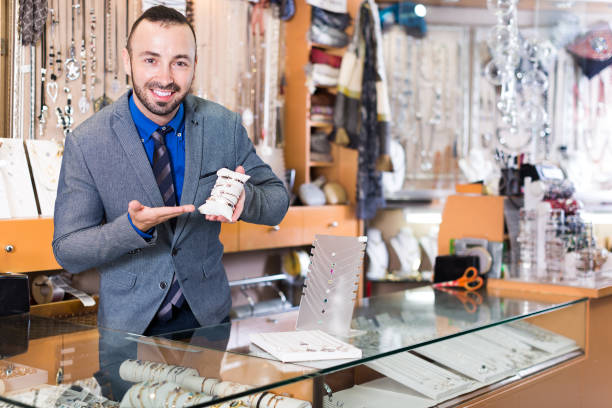
Please, drum roll! This is your guide to deep knowledge and real-world examples of buyer personas for the jewelry industry. For good measure, we’ve added a little glimmer!
This guide will help you navigate the world of buyer personas and tailor your luxury branding to the unique needs and desires of your customers. This guide will help you navigate the world of buyer personas and tailor your luxury brand according to your customer’s individual needs.
Prepare to learn valuable insights about the art and science behind persona creation, whether you are a seasoned marketing professional or new to the industry. We will explore jewelry buyer persona examples to inspire and share best practices so that your marketing efforts are always on target.
The Art and Science of Persona Creation
In order to create a buyer persona for your jewelry business, you must first conduct a detailed analysis of your current clientele. Each represents a different aspect of your market. It is important to conduct qualitative and quantitative research. This will reveal valuable insights.
It is important to understand and address the specific pain points of each buyer persona, including budget constraints, ethical concerns about sourcing, or the desire for a personalized experience, in order to develop effective marketing strategies.
Customer Feedback is essential for gaining insight into the preferences and expectations of your audience. Customer-facing team insights are also vital as they add a human element to your data and enrich the narrative of buyer personas.
Tools for analytics like Google Analytics and your CRM are also essential to navigate through a wealth of data. This will help you discover insights that are as valuable as diamonds. Create buyer personas to communicate these insights clearly and compellingly. This will ensure that they are memorable and easy to share across your company.
Remember that all team members, from sales to design, must understand and appreciate personas since they are the foundation of any marketing strategy.
How to Decode the Buyer Persona of a Jewellery Label
In order to create a buyer persona, you will need to dig into demographic and psychographic information. This means that you must understand your customer from many different angles.
Take a look at a woman’s buyer persona, which includes not only basic demographic data like age, income, and occupation but also deeper psychographic information such as aesthetic preferences, lifestyle, and personal values. A man’s buyer persona might focus on different things, like style preferences, brand loyalty, and buying behavior.
To avoid getting confused by all these details, we suggest working with experts from a href=”https://digitalagencynetwork.com/agencies/usa/industry/luxury/”>luxury marketing agencies/a>. We recommend working with experts at luxury agencies to avoid getting confused by these details.
Building Your Buyer Personas
After you have gathered all the responses, now is the time to begin the process of creating your persona.
Start your journey by dividing feedback into categories based on similarity.
Grouping similar answers: Analyze the feedback collected extensively to identify themes and patterns. These insights will help you develop diverse personas that highlight the characteristics of different segments within your audience.
Creating Individual Personas: After analyzing the feedback, create detailed personas. Please pay attention to all aspects of your personas, from their backgrounds to their preferences.
Give your personas names and photos to make them more relatable and tangible.
Demographic depth: Include key demographic details such as age, income, and relationship status in order to give your personas more depth.
Voices Of Customers: Incorporate real customer quotes from surveys. It gives the personas a more authentic feel as they reflect real needs, wants, and perceptions about your jewelry.
Strategy for Each Persona: Tailor your marketing to the unique preferences of every persona. If, for example, the persona values jewelry expertise, make sure your marketing reflects that.
Create a Persona blueprint: Compose each persona in a concise one-page document. This is a useful reference that helps you to ensure that your marketing efforts are targeted precisely according to each persona’s preferences and characteristics.
Understanding B2C Personas and B2B Personas for Jewellery
Understanding the differences between B2C and B2B personas, as they are in other industries, is essential for jewelry businesses.
B2C marketing focuses on the individual customer and tailors it to their personal preferences, emotions, lifestyle choices, etc. Women’s and men’s buyer personas are created in the jewelry industry to emphasize emotional engagement and brand identification. B2B is aimed at businesses such as retailers and designers and prioritizes bulk purchases, quality assurance, and reliable supply.
Marketing here is geared towards long-term relationships and emphasizes product consistency. B2B relies on reliability, consistency, and scalability. B2C strategies are based on personal connections and emotional storytelling.
A B2C approach might focus on eco-friendly jewelry for environmentally conscious customers, while a B2B campaign would highlight the reliability of a jewelry maker and its exclusive designs for retail chains. Understanding these needs allows you to create targeted strategies that will help improve your marketing efforts and strengthen customer relationships.
Examples Of Buyer Personas For A Jewellery Brand
We’ll explore diverse examples of buyer persona jewelry, including different demographics and genders. We are more than willing to share our best practices so that your marketing efforts will be tailored to the target audience and effective.
Katie Dean Jewellery: A Real-World Buyer Persona Example
We’ll look at a real-world jewelry example to show how these principles are put into practice.
Take a look at the case study on Katie Dean Jewelry as presented by Joy Joya. This example shows how a real jewelry brand, Katie Dean Jewelry, was able to identify and tailor its marketing strategies for its target audience.
Katie Dean Jewelry created a detailed persona of its audience by carefully analyzing the product line and marketing strategy. This enhanced their connection to their target market. This case study highlights the importance of engaging and understanding the unique characteristics of your audience. It is a crucial aspect of creating effective buyer personas for the jewelry industry.
This integration is not only a real-life, tangible application of creating buyer personas but also highlights the importance of detailed marketing analysis and targeted strategies in the jewelry sector.
Common mistakes and best practices
It is important to tread carefully when creating buyer personas in the jewelry market. These dynamic and intricate representations require constant refinement to keep up with market trends and changing customer preferences. Here, the primary caution is to avoid oversimplification. If you reduce your personas into a few broad strokes, it cannot be easy to understand your audience. You may miss the rich tapestry of their motivations and wishes.
Stereotyping is also dangerous. Personas created based on cliches or assumptions can lead to misguided marketing strategies. They may also alienate segments of your target audience and cause your Luxury Advertising campaigns to target the wrong audiences.
It’s important to dig deeper and acknowledge the uniqueness and diversity of your clients.
It’s not just about creating personas but also how you use and interpret them. Your strategies can be ruined if you rely solely on your gut feeling without considering actual data. You can use metrics to evaluate the impact your personas have on engagement and sales.
This analysis must go beyond simple numbers. It is about decoding all the subtleties and nuances that these figures represent.
Conclusion
This guide will take you through the process of creating compelling buyer personas. We’ll focus on both men’s and women’s jewelry, which is essential for any successful jewelry brand. We’ve explored the entire spectrum of creating buyer personas for both men and women in the jewelry industry.
Remember that success is a result of constantly refining your personas to reflect the changing tastes and preferences of your audience. Let these insights guide you as you embark on a journey of discovery with your audience and connect with them.






